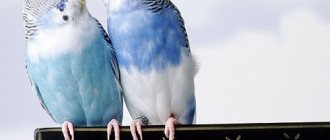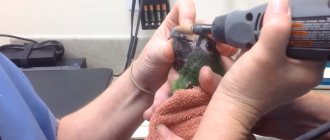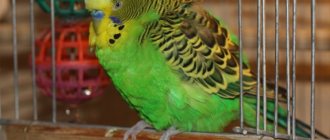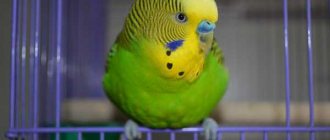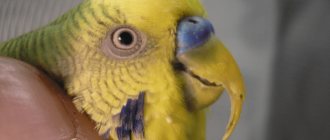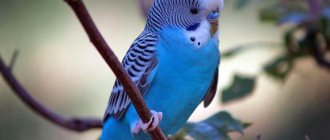Regardless of the species, any parrot can develop health problems. The convulsive state of the pet is of particular concern. It requires immediate contact with specialists - ornithologists or veterinarians. Convulsions in parrots can occur for various reasons, but the symptom indicates a serious disorder in the central nervous system, and untimely assistance can quickly lead to the death of the bird. Let's try to figure out what provokes this condition and how we can help the parrot.
Causes of seizures in parrots
A cramp is a spontaneous, uncontrolled muscle contraction. For birds living in their natural habitat, most diseases of birds kept in captivity are uncharacteristic. Experts say that recently cases of central nervous system diseases have become more frequent, which most often provoke seizures in parrots.
The most common causes of seizures:
- cerebral hemorrhage,
- circulatory disorders,
- tuberculosis,
- polio,
- thyroid disease,
- large deficiency of minerals and vitamins,
- acute infectious disease psittacosis,
- streptococcosis,
- tumor diseases,
- salmonellosis,
- poisoning with nicotine, lead (can be contained in cage bars or in household paint), zinc (if pet food was kept in containers made of this material), herbicides (from feed).
Calcium deficiency leads to seizures in gray parrots. This phenomenon is observed in representatives of the species aged 2-5 years. The special structure of the gray parathyroid gland often leads to mineral deficiency - hypocalcemia. In addition to a convulsive attack, the bird may unexpectedly fall from its perch when it is stressed or frightened by noise. The problem is solved by adding calcium gluconate to the parrot's food.
Deficiency of vitamin D and group B is often the cause of disturbances in the functioning of the nervous system. As a result, the bird is not able to orient itself normally in space, convulsions and seizures are noticeable. Subsequently, blood circulation is often disrupted and joint problems begin. The problem is solved by correcting the diet, which should be varied and balanced.
Poisoning from drugs, detergents, paints and perfumes.
In this condition, the color of the feces changes, coordination of movements is impaired, and parrots become paralyzed on one side: the paw along with the wing. This is the most common cause of body paralysis or seizures in budgies. They are incredibly curious, which is why they often get into various troubles and taste non-food products.
Diagnostics
For an accurate diagnosis, it is important to collect an anamnesis: the frequency of attacks, the bird’s diet, the appearance of the litter, and living conditions. The attacks themselves do not provide a complete picture of what is happening. Some symptoms may not be noticed by the owner or not given due attention.
On the one hand, poisoning is easiest to identify as the most common cause. In addition to cramps, it is accompanied by vomiting, diarrhea and severe dehydration. The bird becomes lethargic and disheveled and loses its appetite. On the other hand, if the parrot is having contractions, it means that the poisoning is severe and the nervous system is damaged. The parrot's condition is rapidly deteriorating, so in this case it is important to make a timely diagnosis and begin treatment. You should be wary if your parrot is vomiting, has problems coordinating movements, or has changes in the color or consistency of feces.
In case of poisoning, laboratory tests must be carried out. This will help determine the cause. Poisoning occurs due to taking antibiotics or overdosing on other medications. Toxic fumes in a room where birds are constantly present, for example, cigarette smoke, perfume, detergents, provoke disease. The reaction can occur with galvanized dishes in which table and table salt is given.
Unfortunately, bouts of hemorrhage or concussion as a result of trauma are incurable.
Infectious diseases are characterized by periods of sudden stiffness. In addition, the bird becomes lethargic, breathes heavily, and its eyes are purulent. In this case, as in the case of poisoning, research and an accurate diagnosis by an ornithologist are important.
Renal failure is manifested by refusal of food and water with severe polyuria. At the same time, the parrot actively loses feathers, its limbs turn upside down. The attacks are sudden. An examination is necessary to avoid missing an infection.
How do seizures manifest?
Unfortunately, the parrot does not always flutter around the room and chirp cheerfully while sitting on a perch. When he becomes seriously ill, he may begin to behave differently than usual:
- suddenly begins to beat against the walls of the cell,
- rhythmically turns his head from side to side,
- throws his head back,
- loses orientation in space,
- clenches his beak tightly,
- lies on the stomach or side,
- convulses and spasms,
- his paw stops working, or even both,
- paralyzed, the pet falls to the bottom of the cage and lies with its eyes open, its wings spread and not moving.
There are also accompanying symptoms: diarrhea, lack of appetite, constricted pupils and a “non-bird” squeak emitted from time to time by the parrot.
Do not try to treat a parrot when it has convulsions and all other symptoms; immediately seek help from an ornithologist. Not all even experienced budgerigar breeders know what to do in such cases, so qualified help is needed.
Why is he shaking his head?
An animal may shake its head for a number of reasons:
To exclude these diseases, it is necessary to conduct a visual inspection for damage and palpation of the bird’s body: wings, legs, body. A healthy person shakes his head with worry, fear or curiosity. The inflammatory process may be accompanied by nausea and diarrhea.
The grains are stuck in the crop
Cockatiels and budgies should not be fed large, unmixed grains. When swallowing, the bird may not completely separate them, which will cause pain in the crop. The wedge-shaped element can be gently palpated. Ignoring the symptoms leads to the animal being thrown out. Trembling of the body is sometimes accompanied by the release of food from the beak, which can occur in case of overeating.
Presence of a tracheal mite
The tracheal mite is a parasite that lives in the upper respiratory tract of feathers and feeds on the contents of secretions, affecting the respiratory system: trachea, larynx. As the tick grows, it limits the supply of oxygen. Corella begins to shake her head from side to side, trying to breathe.
What to do, how to help the bird
The problem is that the appearance of seizures in a pet can often baffle even an experienced specialist. The problem lies in diagnosing the disease. You can’t focus on just one symptom—convulsions. You need to evaluate everything that happens to the parrot.
Unfortunately, it is not always possible to notice all the symptoms of illness. Therefore, the doctor usually prescribes drugs that have a general strengthening effect.
It is easier to make a diagnosis if the parrot has seizures due to intoxication. There are accompanying obvious symptoms of poisoning: vomiting, diarrhea, and dehydration.
First, laboratory tests are carried out, then a diagnosis is made, and only then the parrot is given medications. Otherwise, if you start feeding him medications, having incorrectly determined the cause of the seizures, you may not only not help him, but will worsen his condition.
Everything you should provide at first when your pet is in a convulsive state:
- Despite the lack of appetite, the parrot needs to eat regularly, so prepare a nutritious slurry from dairy-free baby formula and water, and pour it into the bird’s beak with a syringe. It is enough to give 2-3 ml three times a day. This will give your pet energy and eliminate dehydration.
- To relieve the bird from convulsive spasms, prepare a solution of calcium gluconate: dilute 1 ml of calcium gluconate in ampoule form in 10 ml of slightly warmed water. You can solder the parrot with the solution, pouring 2-3 ml at a time with a syringe through the beak several times a day. Or simply adding the solution to the sippy cup. The course is five days.
Attention! The break between meals for parrots should not exceed six hours. If the bird refuses to eat, you will have to force feed it.
All processes in a bird’s body proceed quickly, so there is no need to hesitate. Act immediately as soon as you see that the parrot is feeling unwell. Otherwise, neglected condition and improper treatment can lead to the death of the pet.
Diagnostics
It is easiest for an ornithologist to recognize the symptoms of poisoning and prescribe appropriate treatment. In this case, the budgerigar experiences vomiting, dehydration and diarrhea. The cause of poisoning can be not only expired food, but also harmful bacteria entering the bird’s body. Laboratory tests can reveal the presence of pathogens.
It is not possible to accurately diagnose what triggered convulsive manifestations in all cases. Most medications are prescribed to maintain your pet's current well-being. In some cases, initial treatment is not carried out properly, which can worsen the parrot's condition.
Prevention
When you look at photographs or videos of sick birds, you really want such a disaster to never happen to them. Having a parrot, you take on great responsibility, so try to provide it with good conditions. It is not difficult to prevent seizures in parrots, but it is more difficult to treat your pets for them:
- clean the bottom of the cage daily, wash the tray with soap twice a week;
- Wash feeders and water bowls thoroughly every day;
- Disinfect the entire cage every three months with a 3% formaldehyde solution;
- frequently ventilate the room where the parrot is kept, avoid any strong odors;
- purchase only high-quality food, regularly change wet food in the feeder - if it has lain in the feeder for more than 6 hours, it becomes unsuitable for eating;
- do not give your parrot boiled water, it is optimal to give children’s bottled water, without gas;
- do not feed the bird food from your table, human food is not suitable for the parrot;
- Keep an eye on the variety and balance of your pet’s diet: in order to fully develop and live a long time, he must regularly receive all the necessary substances (vitamins, minerals, trace elements).
Important! If you have other parrots, do not place a newbie with them immediately after purchase. Stay in quarantine for at least a month.
Budgerigars are often carriers of parasites and infections, so quarantine is mandatory if you want to protect all your pets from disease.
As soon as you see the first symptoms of the disease, contact a specialist at the clinic. Your timely response and recommendations from an ornithologist can save the life of your feathered friend.
Why does the wings and tail tremble?
The criteria determine the cause of body and tail tremor and pathological symptoms.
If a budgie hides its head under its wing, this can cause chills and inflammation; it is necessary to warm the bird as soon as possible. If the inflammatory process is not treated, the animal will soon die.
Change of home
A change of environment is a tragedy for an animal. A new room, loud sounds, people around who often attract attention - all this frightens the baby. This is manifested by body trembling. In order for your pet to quickly get used to the prevailing atmosphere, you should leave him alone in the cage for several hours. Then gradually accustom him to yourself by talking, feeding, and caressing him with words.
Change of owner
Corella can tremble not only from cold and pathological reactions in the body. A change of owners is a blow for a feathered bird. The bird has short-term memory and forgets its old owner within 2 months. To avoid frightening the bird, visit it every three hours on the first day, and the next day increase the frequency of visits to the cage.
In gentle conversations, use friendly intonation and affectionate phrases that can positively affect the animal’s mood.
Loud sounds
To quickly adapt the parrot, you cannot turn on medium and loud devices: TV, tape recorder, speakers, telephones. Fear can kill a bird, because stressful situations are accompanied by a rapid heartbeat and the release of the fear hormone adrenaline into the blood, which leads to an increased heart rate. The heart muscle cannot withstand heavy loads.
Symptoms of heart palpitations are very difficult to detect, to prevent serious consequences, do not make sudden movements near the cage and talk loudly.
Corella loves peace and quiet, do not turn on the equipment at medium volume.
A pet is a joyful excuse for children to check, touch and pet a feathered pet, which is highly undesirable. Excited screams and emotions can disturb the peace and cause resentment in the cockatiel. Not allowing children to see a new bird can cause crying and even hysterics. In order to please everyone and not spoil the calm and warm atmosphere in the family before the performance.
Before introducing a parrot, children should be warned that from now on they will speak in a quiet voice and play only quiet games, otherwise the bird will fly away to other obedient, calm children. Symptoms of fear manifest themselves in the form of body tremors and sitting posture. The animal does not like noisy environments. The cage should be spacious and neat.
Your pet will not tremble if sanitary standards are observed at all times.
Poor nutrition
You should know that birds have a fast metabolism. Microelements must be supplied regularly. The diet should include: ground cereals with the addition of dried cereals, fruits, vegetables, fodder. A cockatiel will shiver in its cage if there is not enough food.
Growths, peeling
Every parrot develops tumors on its legs at least once in its life. Ugly growths are a consequence of processes in the skin caused by the activity of parasites. A common infectious disease among birds is knemidocoptic mange, a scabies mite.
Microorganisms colonize unfeathered areas of the skin, make passages in them, feed on particles of the epithelium and secrete their waste products inside. Moving in the skin, the scabies mite causes unbearable itching; the bird constantly itches and pecks at the metatarsus. The skin becomes loose, peels, and the surface layer crumbles.
Growths on the paws
Treatment for scabies is simple, but long-term. The affected paws of the parrot are treated with aversectin ointment according to a special scheme. Unfortunately, recovery does not guarantee that the parrot will not contract the disease again in the future. Ticks are carried on tree branches and used equipment. You can become infected from other birds if quarantine is not observed.
On a note! Growths on the paws appear not only with knemidocoptosis. Excess calcium causes calcareous deposits on the metatarsals in the form of plates. You can cope with this problem by adjusting your diet.
Stomping his paws on the floor
No matter how strange it may sound, parrots can also stomp their paws, like other pets. It looks a little ridiculous: the bird stands still and suddenly jumps up, stamping with one paw. It can be assumed that she is bothered by discomfort in her limbs and is trying to get rid of it. Most likely, this behavior is caused by parasites living on the skin and feathers.
Carry out a thorough examination of your pet: examine the space between the feathers, touch the skin on the wax, pay attention to the cloaca, eyes and beak. Check the length of the nails to see if it's time to trim them. If you don't notice anything suspicious, perhaps the bird is just playing like that.
Diseases and injuries to the paws are serious troubles, due to which the quality of life of a parrot is noticeably reduced. It is important to respond to pathological changes in a timely manner and not to forget about the basic rules of bird care.
Preventive actions
Strength caused by nervous system disorders is directly related to the quality of animal care and a balanced diet. The body of a parrot is delicate, so they are very dependent on the cleanliness of the room in which they constantly stay. A bird may react to substances that do not pose a threat to its owner. The room in which the cage is located must be regularly ventilated, cleaned with moisture, and avoid the accumulation of dust and dirt. It's a good idea to maintain a reasonable level of humidity to prevent the spread of bacteria and infection. Don't go pale in the room, don't use perfume or spray, don't paint your nails.
Poor quality or expired food can lead to poisoning, so don't skip it. Allow bird hook and human food, watch out for alcohol left in accessible place. Water should be changed daily, preferring bottled or steamed water rather than boiled. The cage is cleaned daily with both a sanitized bladder and a sanitized feeder. The cuvette is washed with soapy water every 4 days, and the entire frame is treated every week with three percent formaldehyde. Potted plants should be placed in the room with care. For example, Philodendron is deadly poisonous to parrots.
Hot paws
The legs overheat if the pet moves actively. A parrot's paws become hot if it intends to attack an opponent, peck its owner, or grab a tasty morsel. It depends on your temperament. In sluggish, boring individuals, the limbs are almost never hot.
You can talk about pathology if certain areas of the paws are much warmer. Typically, with joint diseases, the affected areas are hot, while the remaining areas are at normal or slightly lower temperatures. When a bird feels bad, it sits lower on the crossbar and spreads its legs wide.
This is interesting! A bird’s body temperature is 2–4 degrees higher than a human’s, so out of habit it seems to us that the parrot has hyperthermia. An electronic thermometer will help you cope with panic: you need to record several indicators during the day to make sure the bird is healthy.
